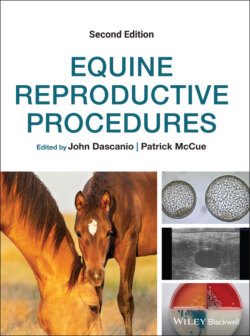Читать книгу Equine Reproductive Procedures - Группа авторов - Страница 37
Additional Comments
ОглавлениеThe advantages of qPCR assays to veterinary practitioners include rapid analysis of a sample (i.e., 2 hours) and the potential ability to detect the presence of microbial DNA in cases of infectious endometritis where traditional culture was unsuccessful. In our experience, the time interval from sample submission to identification of a positive or negative result for pathogen DNA is about 6 hours, with sequencing and final reporting of the causative agent approximately 24–48 hours later. Early detection of an infection will allow practitioners to make informed clinical decisions regarding antimicrobial therapy days before traditional culture results would be available. An added advantage of qPCR is that the assay offers the possibility of monitoring bacterial or fungal DNA levels during antimicrobial therapy. A reduction or absence of microbial DNA, as determined by qPCR, during therapy would indicate progress toward resolution.
A current limiting factor for qPCR analysis of equine samples is availability of the technology. Currently qPCR analysis is only available in selected diagnostic laboratories. However, it is anticipated that simple point‐of‐care (POC) molecular diagnostic qPCR systems that are currently available in human medicine will be incorporated into veterinary clinics in the near future.
Currently, qPCR assays typically cost around US $95 in most veterinary diagnostic laboratories, with results available in a few days. Microbial culture of fungal organisms and identification typically costs approximately $55, with results available in several days to weeks. One limitation of molecular assays is the inability to determine antimicrobial susceptibility patterns. Clinicians using qPCR to detect microbial organisms, such as fungal organisms, may use anecdotal experience to develop an appropriate treatment plan. As the mechanisms of resistance are better understood in fungal organisms, molecular techniques may be utilized to determine the potential for an organism to have inherent resistance to certain antifungal agents. We anticipate that in the future we should be able to detect, identify, and determine antifungal susceptibility patterns based on an organism’s DNA signature.
Uterine samples collected for qPCR should be collected and handled with minimal contamination. Samples that are “sterile” may not have microbial growth, but the DNA of microbial pathogens may still be present. DNA contamination is one cause of a false‐positive diagnosis when using a molecular‐based assay. Steam autoclaving will reduce the amount of microbial DNA present on equipment. Glass blood tubes without anticoagulant and new 15 or 50 ml centrifugation tubes appear to have minimal microbial DNA.
The equine uterus has historically been noted to be a “privileged site” that should be free of all microbial organisms and therefore no microbial DNA should be present in uterine samples from “normal mares.” However, recent studies have suggested that the equine uterus may contain a normal flora of non‐pathogenic microorganisms.
Deep‐seated infections and/or organisms in a biofilm may be present in an arrested state with a low replication rate, which may make detection difficult using traditional microbial culture. However, these quiescent organisms still contain DNA and may yield a positive qPCR result.
Detection of microbial DNA by qPCR and failure to detect organisms by traditional culture may be due to: (i) the ability of qPCR to amplify the DNA of non‐viable organisms and free fungal DNA; (ii) the failure to provide the appropriate growth conditions for fungal organisms (agar, temperature, etc.); or (iii) the organism having an extremely low replication rate in which growth may take weeks to months.
Clinicians should use caution in interpreting the results of qPCR assays as they are often extremely sensitive and may detect DNA from dead organisms and may not match the clinical picture of a case. Negative controls may exhibit microbial DNA detection (i.e., contamination with dead bacterial DNA) by 35 or more Ct cycles. A “positive” signal from a clinical sample beginning at 35 Ct cycles or more should be considered to be the result of contamination. A sample is considered to contain organisms that are biologically relevant if microbial DNA is detected in the first 30 Ct cycles. Adequate controls of known organisms at set CFUs should be utilized to confirm that the qPCR assay is functioning normally and to estimate the organism load in a clinical sample.
